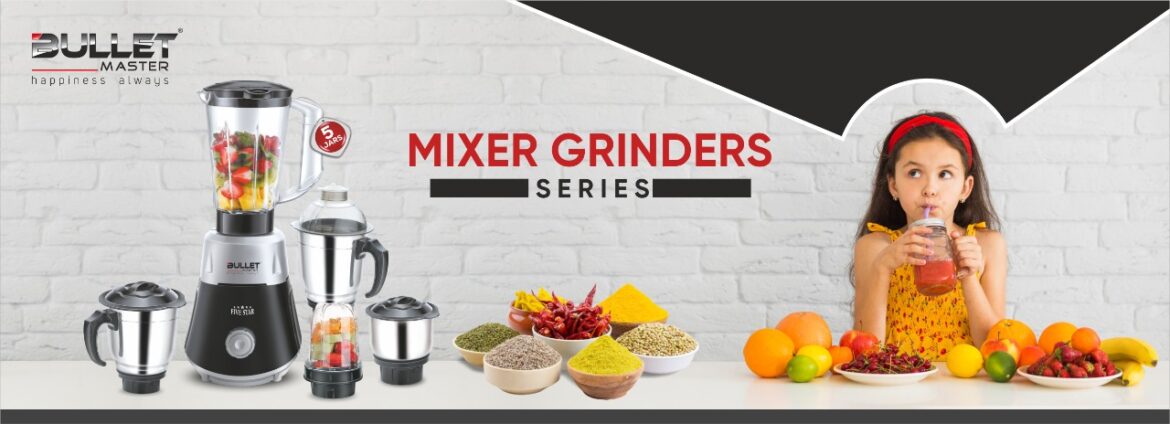
When it comes to essential kitchen appliances, the debate between a juicer mixer grinder and a mixer grinder continues to confuse many buyers. If you’re planning to upgrade your kitchen or buy a new multi-functional appliance, it’s important to understand the difference between the two and which one truly fits your needs.
In this blog post, we’ll explore the functions, benefits, and key differences of both appliances—helping you make a smart and practical choice. Whether you’re a health enthusiast who loves fresh juice or a home cook preparing elaborate dishes, the right kitchen appliance can make your life easier.
What Is a Mixer Grinder?
A mixer grinder is a versatile appliance used for grinding, mixing, and pureeing food items. It usually comes with two or three jars meant for dry grinding (like spices), wet grinding (like chutneys), and blending (like smoothies or batters).
Common Features of Mixer Grinders:
-
Dry grinding jar for spices, cereals, coffee beans.
-
Wet grinding jar for chutneys, dosa/idli batter.
-
Multipurpose jar for blending or pureeing.
-
High-speed motor with multiple speed settings.
-
Compact and suitable for everyday cooking.
Ideal For:
-
Making chutneys, masalas, batters, and pastes.
-
Blending ingredients for smoothies and shakes (to some extent).
-
Grinding tough ingredients like turmeric or cardamom.
What Is a Juicer Mixer Grinder?
A juicer mixer grinder (JMG) is an upgraded version of the standard mixer grinder. It includes all the mixing and grinding functions but comes with an additional juicer attachment for extracting juice from fruits and vegetables.
Common Features of Juicer Mixer Grinders:
-
All functions of a mixer grinder.
-
A juicing chamber or jar with a strainer or mesh.
-
Can be centrifugal or cold press (in advanced models).
-
Separate jar or attachment for juicing.
Ideal For:
-
Health-conscious users who want fresh fruit/vegetable juices daily.
-
Households that want both grinding and juicing in one appliance.
-
Saving kitchen space by combining appliances.
Key Differences: Juicer Mixer Grinder vs Mixer Grinder
Let’s break it down into clear comparison points:
| Feature | Mixer Grinder | Juicer Mixer Grinder |
|---|---|---|
| Functions | Mixing, grinding, blending | Juicing + mixing, grinding, blending |
| Attachments | 2–3 jars (dry/wet/multipurpose) | 3–4 jars (includes juicer jar) |
| Purpose | Cooking assistance | Cooking + health/juice needs |
| Maintenance | Easier to clean | Slightly harder due to juicer parts |
| Size | More compact | Slightly bulkier due to juicer attachment |
| Price | Generally more affordable | Slightly more expensive |
Pros and Cons of Mixer Grinder
✅ Pros:
-
Affordable and compact.
-
Great for daily Indian cooking.
-
Easy to clean and store.
❌ Cons:
-
Cannot extract juice effectively.
-
Limited to grinding/mixing tasks.
Pros and Cons of Juicer Mixer Grinder
✅ Pros:
-
Combines multiple functions in one device.
-
Useful for fitness enthusiasts.
-
Saves space by eliminating the need for a separate juicer.
❌ Cons:
-
Slightly more expensive.
-
Requires more effort to clean juicer attachments.
-
Bulky compared to basic mixer grinders.
When Should You Choose a Mixer Grinder?
Opt for a mixer grinder if:
-
You mostly need it for cooking (grinding masalas, chutneys, batter).
-
You already have a separate juicer at home.
-
You’re on a tight budget or have limited kitchen space.
When Should You Choose a Juicer Mixer Grinder?
Go for a juicer mixer grinder if:
-
You love fresh juices daily.
-
You want an all-in-one appliance.
-
You don’t want the hassle of managing two separate machines.
Tips for Buying the Right Kitchen Appliance
Whether you choose a mixer grinder or a juicer mixer grinder, consider these factors before buying:
1. Motor Power:
For regular household use, a 500–750 Watts motor is sufficient. For juicing and grinding tougher ingredients, you might prefer 750 Watts or more.
2. Jar Material and Capacity:
Look for stainless steel jars with varied capacities. Make sure the juicer jar has a mesh filter for pulp separation.
3. Blades:
Check if the blades are food-grade stainless steel and sharp enough for fine grinding and smooth blending.
4. Ease of Cleaning:
Choose models with detachable parts and user-friendly designs.
5. Warranty:
Always opt for a product with a minimum 1-year warranty for peace of mind.
Conclusion: Which One Wins?
There is no one-size-fits-all answer. If your goal is to support your cooking needs, a mixer grinder is your best bet. But if you also want to boost your health routine with fresh juices, a juicer mixer grinder is the clear winner.
Ultimately, the right appliance depends on your kitchen habits, dietary goals, and space constraints. For many families, the extra investment in a JMG is worth it for the versatility it offers.
So before you hit that “Buy Now” button, evaluate what functions you really need—and let your lifestyle decide which kitchen appliance wins in your home.
Frequently Asked Questions (FAQs)
1. Can I make juice in a normal mixer grinder?
You can try, but it won’t be efficient. A regular mixer grinder does not separate pulp, so the juice may have too much fiber and lack smooth texture.
2. Are juicer mixer grinders good for leafy greens?
Yes, but only certain models with strong motors and better juicing technology (like cold press) can handle leafy greens efficiently.
3. What is the average lifespan of a juicer mixer grinder?
With proper use and maintenance, most juicer mixer grinders last 4–6 years or more.
4. Is cleaning a juicer mixer grinder difficult?
Juicer parts like mesh filters can take more time to clean compared to regular mixer grinder jars. However, modern models come with easy-to-clean designs.
5. Which is more budget-friendly: mixer grinder or juicer mixer grinder?
Mixer grinders are generally more affordable. Juicer mixer grinders cost more due to the added functionality.


